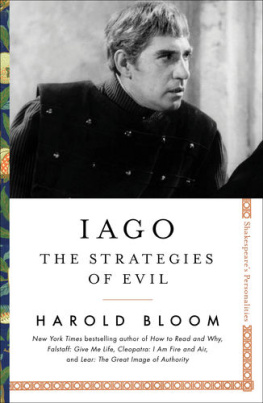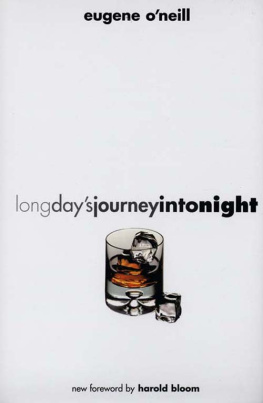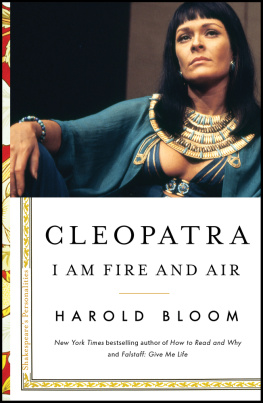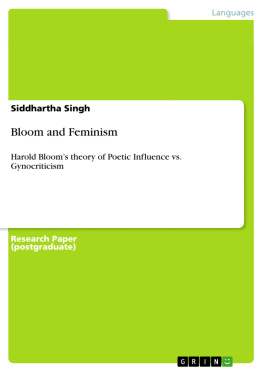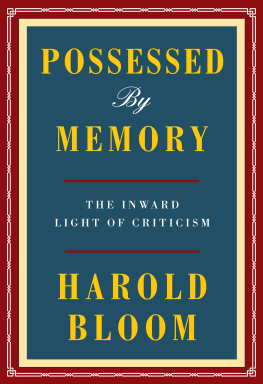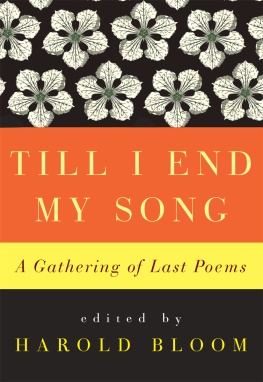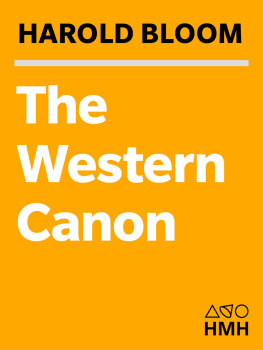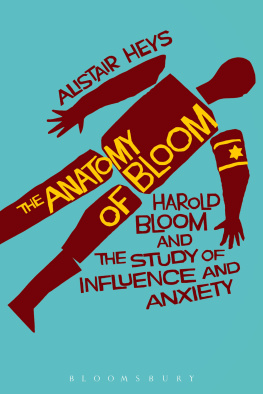THE ANATOMY OF INFLUENCE
The Anatomy of Influence
Literature as a Way of Life
Harold Bloom

Copyright 2011 by Harold Bloom. All rights reserved. This book may not be reproduced, in whole or in part, including illustrations, in any form (beyond that copying permitted by Sections 107 and 108 of the U.S. Copyright Law and except by reviewers for the public press), without written permission from the publishers.
Yale University Press books may be purchased in quantity for educational, business, or promotional use. For information, please e-mail sales.press@yale.edu (U.S. office) or orsales@yaleup.co.uk (U.K. office).
Designed by Nancy Ovedovitz and set in Emigre Filosofia type by Duke & Company, Devon, Pennsylvania. Printed in the United States of America.
Library of Congress Cataloging-in-Publication Data
Bloom, Harold.
The anatomy of influence : literature as a way of life / Harold Bloom.
p. cm.
Includes bibliographical references and index.
ISBN 978-0-300-16760-3 (alk. paper)
1. LiteratureAppreciation. 2. LiteraturePhilosophy. 3. Authors
and readers. 4. Influence (Literary, artistic, etc.). 5. Bloom, Harold.
I. Title.
PN81.B5449 2011
801.3dc22 2010042456
A catalogue record for this book is available from the British Library. This paper meets the requirements of ANSI/NISO Z39.48-1992 (Permanence of Paper).
10 9 8 7 6 5 4 3 2 1
For John Hollander
For art criticism we need people who would show the senselessness of looking for ideas in a work of art, but who instead would continually guide readers in that endless labyrinth of linkages that makes up the stuff of art, and bring them to the laws that serve as the foundation for those linkages.
LEV TOLSTOY, letter to Nikolai Strakhov
CONTENTS
PRAELUDIUM
When I began writing this book, in the summer of 2004, I intended an even more baroque work than it has become. My model was to be Robert Burtons Anatomy of Melancholy (1621), a thousand-page labyrinth that has dazzled me since I was young. My hero and mentor Dr. Samuel Johnson read Burton to pieces, as did my late friend Anthony Burgess and a living friend, Angus Fletcher, who is my critical guide and conscience.
But Burton was my undoing. Even before a debilitating series of mishaps and illnesses, I could not sustain the challenge. Traces of Burtons marvelous madness abide in this book, and yet it may be that all I share with Burton is an obsessiveness somewhat parallel to his own. Burtons melancholy emanated from his fantastic learning: he wrote to cure his own learnedness. My book isolates literary melancholy as the agon of influence, and perhaps I write to cure my own sense of having been overinfluenced since childhood by the greatest Western authors.
In this, my final reflection upon the influence process, I offer commentary on some thirty writers, half of them British, more than a third American, and a few continental. They do not seem to me arbitrary choices: I have written about all of them before, in widely scattered books and essays, but I strive here to render my appreciations fresh and not reliant upon earlier formulations.
Five of these chapters are centered on Shakespeare, and since he is a presence throughout, probably a third of the book is given to him. There are three chapters on Walt Whitman, but he also is widely present in many more, so that another considerable segment is his. What I have to say about both poets has little to do with any currently fashionable accounts of them. Shakespeare plainly is the writer of writers, and his influence upon himself has become my obsessive concern. Walt Whitman, in the four centuries of New World literature in any Western languageSpanish, English, Portuguese, French, Yiddishis the strongest and most original writer of the Evening Land, as D. H. Lawrence first recognized. His inner solitude echoes Shakespeares Edgar and has companions in Dr. Johnson, Lord Byron, and such Lucretian disciples as Percy Bysshe Shelley, Walter Pater, Giacomo Leopardi, and Wallace Stevens. Solitaries in this book also include Ralph Waldo Emerson, James Joyce, Lawrence, the occult seers W. B. Yeats and James Merrillwho ultimately lived only from withinand my personal hero of American poetry, the Orphic Hart Crane.
Fifty-five years of teaching imaginative literature at Yale have taught me better than I myself am capable of teaching others. That saddens me, but I will go on teaching as long as I can because it seems to me a three in one with reading and writing. I had great teachers: M. H. Abrams among the living, Frederick A. Pottle among those departed. I have learned from talking to poets, some of whom are discussed here and some who are not. In ones eightieth year, it is difficult to separate learning from teaching, writing from reading.
Literary criticism, as I learned from Walter Pater, ought to consist of acts of appreciation. This book primarily is an appreciation, on a scale I will not again attempt. In his conclusion to The Anatomy of Melancholy, Burton urges: Be not solitary, be not idle. Samuel Johnson says the same. We all fear loneliness, madness, dying. Shakespeare and Walt Whitman, Leopardi and Hart Crane will not cure those fears. And yet these poets bring us fire and light.
New Haven, Connecticut
July 31, 2010
The Point of View for
My Work as a Critic
LITERARY LOVE
When I was very young, freedom beckoned through the poets I first loved: Hart Crane, William Blake, Percy Bysshe Shelley, Wallace Stevens, Walt Whitman, William Butler Yeats, John Milton, and above all William Shakespeare in Hamlet, Othello, King Lear, Macbeth, and Antony and Cleopatra. The sense of freedom they conferred liberated me into a primal exuberance. If women and men initially become poets by a second birth, my own sense of being twice-born made me an incipient critic.
I do not recall reading any literary criticism, as opposed to literary biography, until I was an undergraduate. At seventeen I purchased Northrop Fryes study of William Blake, Fearful Symmetry, soon after its publication. What Hart Crane was to me at ten, Frye became at seventeen: an overwhelming experience. Fryes influence on me lasted twenty years but came to an abrupt halt on my thirty-seventh birthday, July 11, 1967, when I awakened from a nightmare and then passed the entire day in composing a dithyramb, The Covering Cherub; or, Poetic Influence. Six years later that had evolved into The Anxiety of Influence, a book Frye rightly rejected from his Christian Platonist stance. Now, in my eightieth year, I would not have the patience to reread anything by Frye, but I possess almost all of Hart Crane by memory, recite much of it daily, and continue to teach him. I came to value other contemporary criticsWilliam Empson and Kenneth Burke particularlybut have now dispensed with reading them also. Samuel Johnson, William Hazlitt, Walter Pater, Ralph Waldo Emerson, Oscar Wilde I go on reading as I do the poets.
Literary criticism, as I attempt to practice it, is in the first place literary, which is to say personal and passionate. It is not philosophy, politics, or institutionalized religion. At its strongestJohnson, Hazlitt, Charles Augustin Sainte-Beuve, and Paul Valry, among othersit is a kind of wisdom literature, and so a meditation upon life. Yet any distinction between literature and life is misleading. Literature for me is not merely the best part of life; it is itself the form of life, which has no other form.
This book returns me to the question of influence. As a child, I was overcome by the immediacy of the poets I first loved. At ten to twelve years of age, I read for the lustres, in Emersons phrase. These seemed to memorize themselves in me. Hosts of poets have followed, and the pleasures of possession by memory have sustained me for many decades.
Next page

